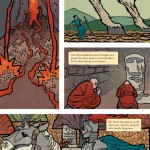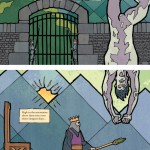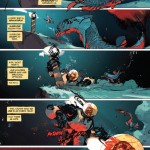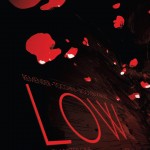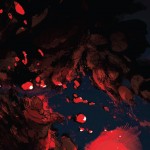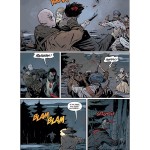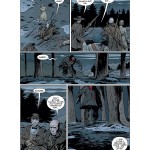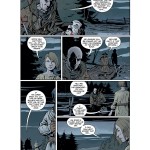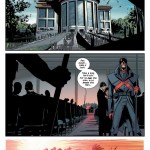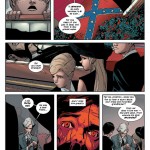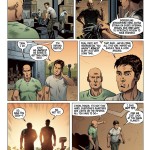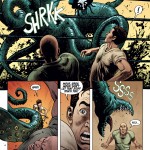It’s Wednesday and that means new comics. Let Deadshirt steer your wallet in the right direction with reviews (with preview pages) of titles out today from Image, Dark Horse, IDW, Boom! Studios, MonkeyBrain, Oni, Fantagraphics, Top Shelf, Action Lab and more!
Fatale #24
Written by Ed Brubaker
Art by Sean Phillips and Bettie Breitweiser (colors)
Image
$4.99
Initially announced as a 12 issue maxi-series when it launched two years ago, Fatale was bumped up to “as long as it takes to tell” by Brubaker and Phillips’ bosses at Image in its first year and here, now, is the very last issue.
Last month’s penultimate issue offered up some really compelling artistic experimentation on Phillips’ end and the opening sequence of this issue (a stained glass-esque fairy tale that serves as a nice summation of the series’ general philosophy) is gorgeous. At one point, your eyes move down the body of a chained virginal sacrifice while action continues on the immediate right side of the page; the ability of an artist to command where and how a reader looks at a page is crucial and Phillips has us by the scruff of our necks. If that’s not enough, Phillips’ use of white space and surreally warped, almost-melting panels in the issue’s hyper-cosmic climax are perfectly unsettling in their abstractness.
Story-wise, Fatale concludes neatly while staying very faithful tonally to its roots in both noir fiction and Lovecraftian horror with an ending that is violent, bleak, and, at the same time, weirdly hopeful (or as hopeful as this Fatale gets). Endings are tough and Brubaker understands that there is an important inevitability to this kind of story. While this finale doesn’t quite reach the heights of some prior issues, everything clicks into place without feeling too obviously telegraphed. Fatale #24 is an excellent piece of punctuation on the end of what’s been a long and gruesome tale.
– Max Robinson
(Click thumbnails to enlarge)
Low #1
Written by Rick Remender
Art by Greg Tocchini
Lettered by Rus Wooton
Image
$3.99
Low is about optimism in the face of annihilation. In and of itself, this is not a unique concept, especially for a sci-fi novel. What makes it unique: 1) Remender is the writer, a man who admits he is not known for writing optimistic work; 2) the annihilation is something that will inevitably destroy our planet in real life.
Low takes place in the distant future. The sun is expanding on its way to going supernova, and people now live deep undersea in radiation-protected domed cities. The story follows a high-ranking family (a contagiously optimistic mother, a long-winded but determined father, and their three children) as they attempt to lead their people and survive. They also must contend with a lack of contact from satellites sent to scout orbiting worlds, and with a more immediate time frame, outcasts from a rival city who attempt to pirate them. The story ends on a violent, in more ways than one, cliffhanger that will make you want the next issue on the shelves now.
The art is gorgeous. Aesthetically, we are presented with a complex, undersea technological city that feels like it has a history. Despite the beauty of the art, there are some occasional issues with layout. More than a few times, it was unclear who was speaking in group scenes. There were also a couple of occasions where there were scenes shifted back and forth with no warning or indication.
Despite this, Low #1 is everything a first issue should be and more. It answers who, what, when, why, and how in definitive and inventive ways. We are given a definitive sense of place, it’s patently clear that this city has been around for generations, and a strong sense of characters’ underlying motives.
– David Lebovitz
(Click thumbnails to enlarge)
Baltimore: The Witch of Harju #1
Written by Mike Mignola and Christopher Golden
Art by Peter Bergting and Dave Stewart (colors)
Lettered by Clem Robins
Dark Horse
$3.50
When we last saw Lord Henry Baltimore, he’d just killed his greatest enemy, the vampire Haigus. Unfortunately, this revenge did not bring Baltimore the relief he thought it would, as in his last moments Haigus revealed that his master, known as the Red King, would soon awaken to rule the world. Baltimore came to the realization that his work was far from over. In fact, it’d only just begun.
In The Witch of Harju, Baltimore and his companions help a young woman escape the reanimated corpse of her husband, who is singularly interested in killing her, and is willing to kill and maim other people to do it. This seemingly unkillable creature is not the only supernatural occurrence in the area, however, as a nearby town is being plagued by a witch.
Co-writers Mike Mignola and Christopher Golden weave the supernatural so effortlessly into the setting of post-World War I Europe, creating a place and time that feels alien and familiar all at once. Monsters feel possible in this world, where villages are isolated, help is slow to come, and superstition is not only a way of life, but a way of survival. This issue’s break from the mythology-heavy issues that came before is refreshing while also serving to reestablish a world in which Baltimore is necessary.
As usual, Dave Stewart’s understated colors build tension, while pops of red serve to highlight just the right amount of gore. I’m conflicted about Peter Bergting’s art. His faces aren’t very expressive and most characters wear the same dark grimace for the entire issue. Actions can be confusing panel to panel, and I found myself re-reading pages to understand the order of events, especially during the fight scene at the very beginning. This being said, Bergting’s demon-cat captures perfectly the fluidity with which cats leap and run, and, assisted by Stewart’s colors, the pure black and red-eyed creature adds a layer of menace and intrigue to the mystery. Baltimore himself is drawn wide in this book, imposing and muscular–a far cry from the gaunt man previously depicted by Ben Stenbeck–and his silhouette is iconic, burdened as it is with the trademarked whaling spear strapped to his back.
Bergting’s rough style, though jarring at first, feels appropriate in this new post-Haigus world we find ourselves in. Baltimore looks less defined because his mission is less defined: he’s succeeded in killing the creature that murdered his family, and now he has to somehow defeat a larger, more nebulous evil. This is Baltimore after his plan has run out. The goals have shifted, and the endgame is murkier than it has ever been before.
– Christina Harrington
(Click thumbnails to enlarge)
East of West #14
Written by Jonathan Hickman
Art by Nick Dragotta and Frank Martin (colors)
Lettered by Rus Wooton
Image
$3.50
A little over a year into Hickman and Dragotta’s mythical sci-fi western and the shit is finally starting to hit the fan. During the previous thirteen issues, we’ve been treated to some impressive world building, a skill Hickman has displayed elsewhere in the past but here feels employed with a considerable elan. If his Marvel work is broad, sturdy architecture, building giant houses at the day job, East of West is Dad working on his motorcycle in the garage on the weekends. There’s a poise and a patience with this comic that can be frustrating if you just want to get to the fucking fireworks factory, but the methodical pace at which we’re taught this vast universe makes issues like this one more savory.
When a new issue hits, I find myself having to double back and get reacquainted with this cast of characters, their various entanglements and the current state of play, but oddly, I find my enjoyment of the book comes not from a strong connection with any of its characters or a pressing need to find out what comes next, but a comforting affection for watching Dragotta fill in the shapes and rhythms of this world with Hickman. Here, in a particularly impressive scene where the death of the President in a previous issue is revisited as a surreptitious act of betrayal intercut with a nostalgic tale of loyalty, I’m reminded of the obscene power of comics. In six panels, this creative team crafts a moment as brutal and effective as anything the Netflix series House of Cards has done with 26 hours. So, while I constantly find myself lost in the murky war between Death and his former comrades in the Four Horsemen, the poetic intricacies of The Message, or remembering the alliances between the different tribes, I’m more than happy to be so artfully manuevered into being enamored by this fantastical frontier tale of revenge, societal decay and faith. East of West may seem ideal for “wait for the trade” folks, but taking the dosage as prescribed, issue by issue, is still an engrossing venture.
– Dominic Griffin
(Click thumbnails to enlarge)
Deep Gravity #1
Written by Gabriel Hardman, Corinna Bechko, and Mike Richardson (story)
Art by Fernando Baldó and Nick Filardi (colors)
Lettered by Nate Piekos of Blambot
Designed by Nick James
Dark Horse
$3.99
Space is a shitty place to work. Not only are you trapped in a tin can for years at a time traveling to a far-off planet to work yourself to the bone for three years, but everything outside your spaceship and on the planet below wants to kill you. Anyway, it’s a job. In Deep Gravity, Poseidon, a somewhat habitable planet has been found three years’ journey from Earth. Humans can only stay there for a three year stint before the atmosphere causes irreparable harm, so couple that with the travel time, it’s a nine year shift if you want to work there. Steven Paxson doesn’t want to work there, he just wants his ex-girlfriend to tell him to his face why she left, so he signs up.
Deep Gravity is an interesting mix of sci-fi conventions, there’s some EC Comics deadly planet horror stuff in there mixed with 70s “space is a crappy blue collar job” concepts. A lot of that comes through the art, Fernando Baldó’s style is a cool combination of (co-scripter’s) Gabriel Hardman’s more sketchy style in the backgrounds and a more Russ Heath-esque detailed look in the facial expressions of the characters. It really sets a unique mood for the comic, both modern and throw-back. The story feels similar with people joining on for the simple reason to explore what’s out there, along with some deeper conspiracy that is hinted at towards the end.
Science fiction has been really making a comeback in the last few years in comics and Deep Gravity could end up at the top of the list. This first issue drops you into the story and while it provides few answers, it gives you a good reason to come back for more.
– Jason Urbanciz
(Click thumbnails to enlarge)
Be sure to let us know what you picked up this week in the comments below, on Twitter or on our Facebook Page!



